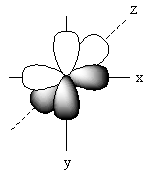
Shape of P-orbital is:
A. Spherical
B. dumb-Bell
C. Double dumb bell
D. None of these
Answer
458.7k+ views
Hint:To determine the shape of p-orbitals we should know the structure of the p-orbital and the number of lobes present in the p-orbital. P- subshell has three orbits. Three orbital shells are denoted as ${{\text{P}}_{\text{X}}}$,${{\text{P}}_{\text{Y}}}$, and ${{\text{P}}_{\text{Z}}}$.
Complete step-by-step solution:The number of orbitals in a subshell is determined by the following formula:
${\text{2l}}\,{\text{ + }}\,{\text{1}}$
Where,
${\text{l}}\,$ is the azimuthal quantum number.
The l value of p-orbital is $1$.
So,
${\text{2}} \times {\text{1}}\,{\text{ + }}\,{\text{1}}$
$3$
The P-subshell has three, ${{\text{P}}_{\text{X}}}$,${{\text{P}}_{\text{Y}}}$and ${{\text{P}}_{\text{Z}}}$orbitals. All these orbitals are degenerate. All orbitals of the p-subshell lie on the axis. So, the electron density of each orbital also lies on the axis. Each p-orbital has two lobes.
The positions of p-orbitals on the axis is represented as follows:

The positions of these three p-orbitals on the axis separately is represented as follows:

Name of each p-orbital depends upon the axis. The p-orbital which lies on the x-axis is known as ${{\text{P}}_{\text{x}}}$ orbital. The p-orbital which lies on the y-axis is known as ${{\text{P}}_{\text{Y}}}$ orbital. The p-orbital which lies on the z-axis is known as ${{\text{P}}_{\text{Z}}}$ orbital.
Each p-orbital has two lobes that are arranged like a dumb bell so, the shape of p–orbital is dumb bell.
So, the shape of P-orbital is dumb-Bell.
Therefore, option (B) dumb-Bell, is correct.
Note:The s-subshell has only one s-orbital. S-orbital has one lobe of spherical shape so, the shape of s-orbital is spherical. D-subshell has five d-orbitals. Out of five d-orbitals, two lie on the axis and three lie in between the axis. ${{\text{d}}_{{{\text{z}}^{\text{2}}}}}$and ${{\text{d}}_{{{\text{X}}^2} - {{\text{Y}}^{\text{2}}}}}$orbitals which lies on the axis and the ${{\text{d}}_{XZ}}$,${{\text{d}}_{YZ}}$, and ${{\text{d}}_{XY}}$ lies in between the axis. Except ${{\text{d}}_{{{\text{z}}^{\text{2}}}}}$all d-orbital has four lobes so, the shape of d-orbital is double dumb bell.
Complete step-by-step solution:The number of orbitals in a subshell is determined by the following formula:
${\text{2l}}\,{\text{ + }}\,{\text{1}}$
Where,
${\text{l}}\,$ is the azimuthal quantum number.
The l value of p-orbital is $1$.
So,
${\text{2}} \times {\text{1}}\,{\text{ + }}\,{\text{1}}$
$3$
The P-subshell has three, ${{\text{P}}_{\text{X}}}$,${{\text{P}}_{\text{Y}}}$and ${{\text{P}}_{\text{Z}}}$orbitals. All these orbitals are degenerate. All orbitals of the p-subshell lie on the axis. So, the electron density of each orbital also lies on the axis. Each p-orbital has two lobes.
The positions of p-orbitals on the axis is represented as follows:

The positions of these three p-orbitals on the axis separately is represented as follows:

Name of each p-orbital depends upon the axis. The p-orbital which lies on the x-axis is known as ${{\text{P}}_{\text{x}}}$ orbital. The p-orbital which lies on the y-axis is known as ${{\text{P}}_{\text{Y}}}$ orbital. The p-orbital which lies on the z-axis is known as ${{\text{P}}_{\text{Z}}}$ orbital.
Each p-orbital has two lobes that are arranged like a dumb bell so, the shape of p–orbital is dumb bell.
So, the shape of P-orbital is dumb-Bell.
Therefore, option (B) dumb-Bell, is correct.
Note:The s-subshell has only one s-orbital. S-orbital has one lobe of spherical shape so, the shape of s-orbital is spherical. D-subshell has five d-orbitals. Out of five d-orbitals, two lie on the axis and three lie in between the axis. ${{\text{d}}_{{{\text{z}}^{\text{2}}}}}$and ${{\text{d}}_{{{\text{X}}^2} - {{\text{Y}}^{\text{2}}}}}$orbitals which lies on the axis and the ${{\text{d}}_{XZ}}$,${{\text{d}}_{YZ}}$, and ${{\text{d}}_{XY}}$ lies in between the axis. Except ${{\text{d}}_{{{\text{z}}^{\text{2}}}}}$all d-orbital has four lobes so, the shape of d-orbital is double dumb bell.
Recently Updated Pages
Master Class 11 Accountancy: Engaging Questions & Answers for Success

Express the following as a fraction and simplify a class 7 maths CBSE

The length and width of a rectangle are in ratio of class 7 maths CBSE

The ratio of the income to the expenditure of a family class 7 maths CBSE

How do you write 025 million in scientific notatio class 7 maths CBSE

How do you convert 295 meters per second to kilometers class 7 maths CBSE

Trending doubts
10 examples of friction in our daily life

One Metric ton is equal to kg A 10000 B 1000 C 100 class 11 physics CBSE

Difference Between Prokaryotic Cells and Eukaryotic Cells

State and prove Bernoullis theorem class 11 physics CBSE

What organs are located on the left side of your body class 11 biology CBSE

Write down 5 differences between Ntype and Ptype s class 11 physics CBSE




